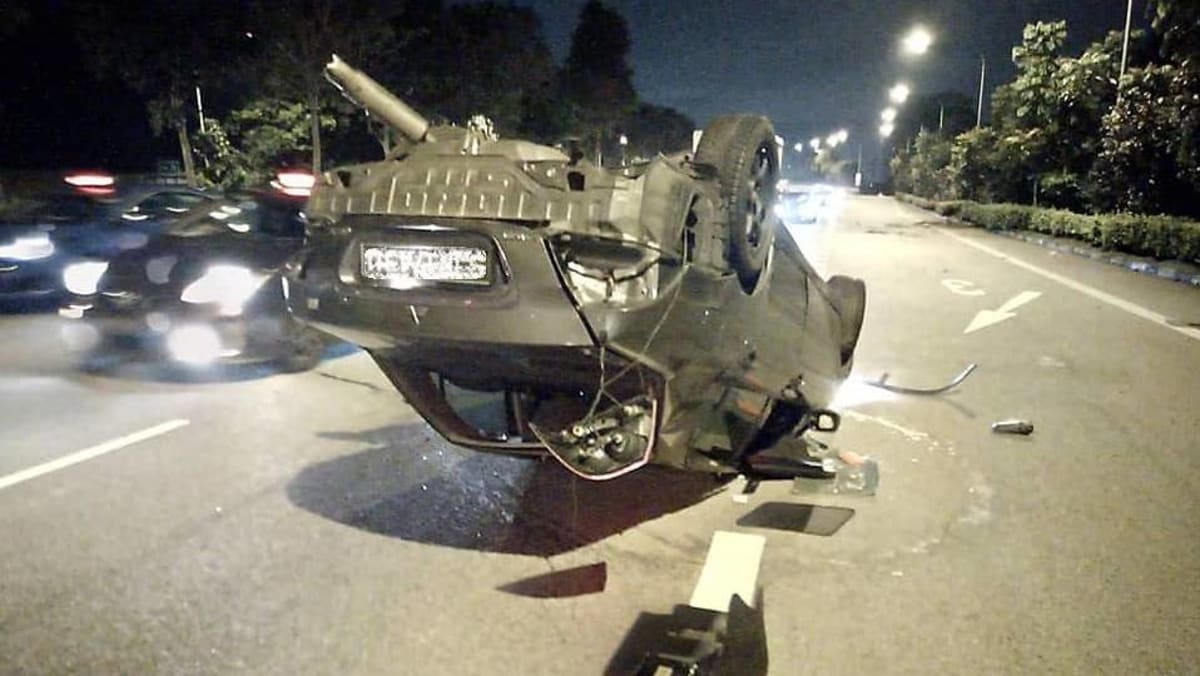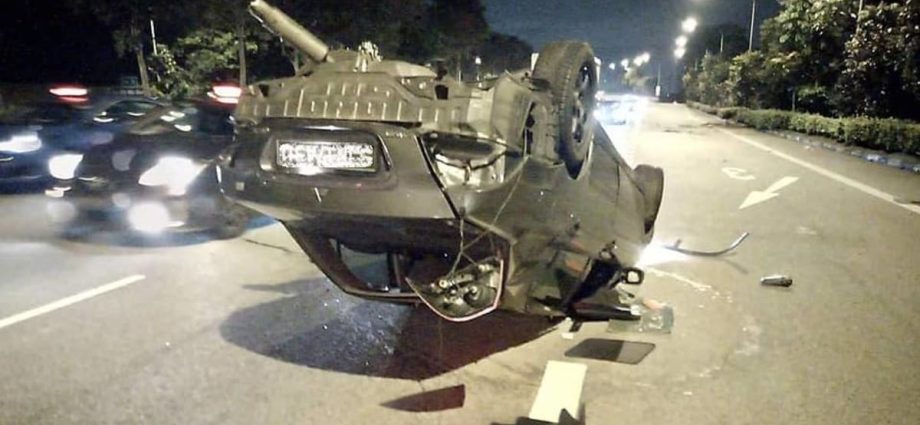
SINGAPORE: The number of drink driving accidents that caused death or injury has gone up in the past three years, with a three-year high of 1,703 drink driving violations reported in 2022.
High-profile accidents with viral footage remain hotly debated online, with netizens questioning if Singapore’s laws are adequate for drink driving and related deaths.
These include the Tanjong Pagar crash, which took five lives, and a speeding Mercedes in Tampines that killed a Gojek driver and severely injured several others.
Last month, a drunk Mini Cooper driver who rammed into back of a stationary food delivery rider was sentenced to 18 months’ jail and a 10-year driving ban.
Statistics provided to CNA by the traffic police last week showed that the number of drink-driving accidents that caused fatalities or injuries went up in the last three years.
There were 146 such cases in 2020, 155 in 2021 and 175 in 2022. The number of drink-driving violations went up from 1,470 in 2021 to 1,703 in 2022. This was a three-year high from 2020, when such violations numbered 1,576.
THE LAW ON DRINK DRIVING
CNA spoke to lawyers familiar with drink driving cases to find out what the laws are, and whether they are adequate.
The offence of drink driving under the Road Traffic Act today is a jail term of up to 12 months, a fine between S$2,000 and S$10,000 (US$1,500 and US$7,400), or both for a first-time offender.
They will also be banned from driving for at least two years.
Repeat offenders face a jail term of up to two years, a fine between S$5,000 and S$20,000, and a five-year driving ban.
Ms A Meenakshi, an associate at IRB Law, said the penalties for drink driving have become harsher over the years.
In particular, she pointed to the 2019 amendments to the Road Traffic Act, which increased the maximum fine and imprisonment term for drink driving.
Before this, the penalties for first-time offenders were a jail term of up to six months, a fine between S$1,000 and S$5,000 and a driving ban of at least 12 months.
Repeat offenders previously faced up to 12 months’ jail, a fine between S$3,000 and S$10,000 and a minimum driving ban of 12 months.
Mr Mitchell Leon, an associate at Characterist LLC, said the maximum sentences were essentially doubled with the 2019 amendments, with the minimum disqualification period also doubled from 12 months to two years.
“It is clear that the enhanced sentencing regime post-2019 was intended to create a strong deterrence to would-be drink drivers, as well as irresponsible or reckless drivers,” said Mr Leon.
CONSEQUENCES OF DRINK DRIVING
The long-ranging potential consequences of drink driving may not appear immediately after having a tipple.
Veteran lawyer Amolat Singh said drink driving situations which lead to injuries can often leave a person maimed and crippled for life, and can rob a family of their breadwinner.
Other than being charged with drink driving, a person can also be charged with dangerous driving or driving without due care or reasonable consideration, said Ms Meenakshi.
“Other than the criminal aspect, a drink driver may also be looking at a civil claim if there was an accident. The claim can range from damages for property damage, personal injury and any other losses,” she said.
Managing director of Characterist LLC, Mr Daniel Goh Choon Wah, whose firm does “a considerable amount” of motor vehicle insurance work, said that in most cases, the insurance contract stipulates that drink driving constitutes grounds for the repudiation of insurance liability.
This means the insurers may not cover a claim.
“In particular, some insurance policies might provide that any amount of alcohol consumed is grounds for repudiation. In other words, the driver need not necessarily exceed the legal limit under the Act of 80mg of alcohol in 100ml of blood,” said Mr Goh.
In such a case, any claim made by the injured party will fall on the driver, said Ms Meenakshi.
“In effect, they will have to pay the damages out of their own pockets. After this, when these drink drivers wish to renew their insurance policies, they may have to pay a higher premium or, in some cases, insurers may refuse to provide any coverage at all,” she said.
“KILLING” SOMEONE WITH A CAR
A common refrain among readers commenting online on stories about fatal drink driving accidents is that a drink driver “gets away” with a meagre penalty for killing someone with a car.
However, Ms Meenakshi said it is a “common misconception” that penalties are too lenient.
“The current laws adequately provide for punishments which are proportionate to the gravity of the crime involved,” she said.
A drink driver who causes death will not only face a charge for drink driving, but also a charge of dangerous driving or driving without due care or reasonable consideration.
On top of this, they will be considered a “serious offender” as defined by the Road Traffic Act, which means they face enhanced penalties.
“With murder, a person sets out with the intention to take someone’s life,” said Ms Meenakshi. “Whereas with drink driving, one does not set out with the intention of causing death. More often than not, drink drivers drive out of convenience.”
She said the punishment for dangerous driving while under the influence, resulting in death, can be harsher than causing death by a rash act. The maximum jail term for causing death by a rash act is five years, whereas a drink driver who causes death can be jailed for up to 10 years in certain situations.
Mr Leon said that when it comes to establishing sentences, a person’s intentions and the “fault element” must be regarded, and not just the result of the criminal conduct.
“While the end result, namely the death of a person, might be the same, it is quite clear that a drink driver does not have the same degree of culpability as a murderer,” he said.
On whether the existing penalties for drink driving are sufficient, Mr Singh said it is “a tricky business” to determine penalties.
“Therefore, the authorities take a calibrated and graduated approach. The penalties are adjusted by looking at the statistics of such offences and if they are on the rise despite the enhanced penalties, then the penalties are made a little higher,” he said.
It might not be enough to increase the jail term and the fines alone, which is where a driving ban comes in, he said.
The 2019 amendments to the law expanded the scope for the traffic police to have the discretion to impose immediate suspension for all dangerous driving offences, as well as careless driving offences that cause death or grievous hurt.
Driving bans are directed at protecting the safety of motorists and the general public as they keep dangerous drivers off the road and bar offenders from causing any future harm, said Mr Singh.
THE LAW “CAN ONLY DO SO MUCH”
Mr Goh said there seems to be a general awareness among offenders that the penalties have become tougher post-2019.
“That being said, the fact that offending behaviour remains seemingly prevalent might suggest that the law can only do so much to deter errant behaviour,” said Mr Goh.
“One possible reason for this is that drink drivers may find themselves in situations where they think they have no choice but to drive their vehicles home or otherwise leave their vehicles stranded wherever it was that they were drinking,” he said.
“Naturally this cannot be an excuse or a justification for criminal conduct, but perhaps the solution lies not in harsher laws but in the greater availability and/or awareness of options as an alternative to drink driving.”
In a statement to CNA, the traffic police said they take a strong stance towards drink driving.
“All motorists are urged to practise good road sense and get home safely to their loved ones,” they said.

